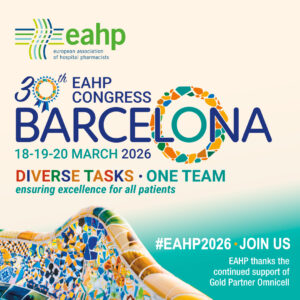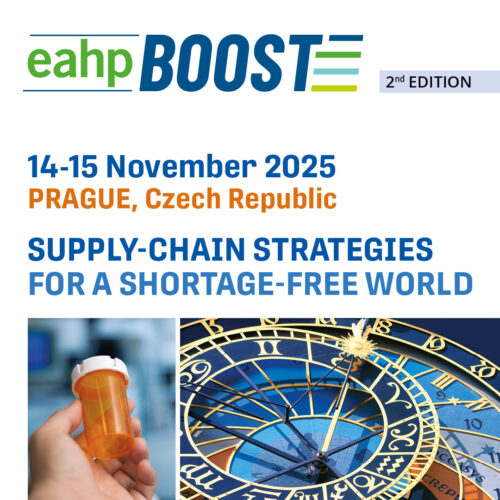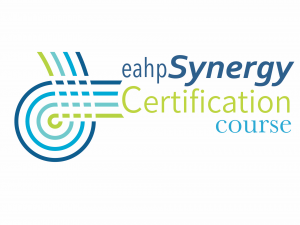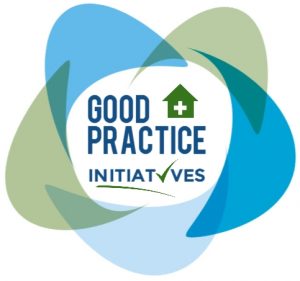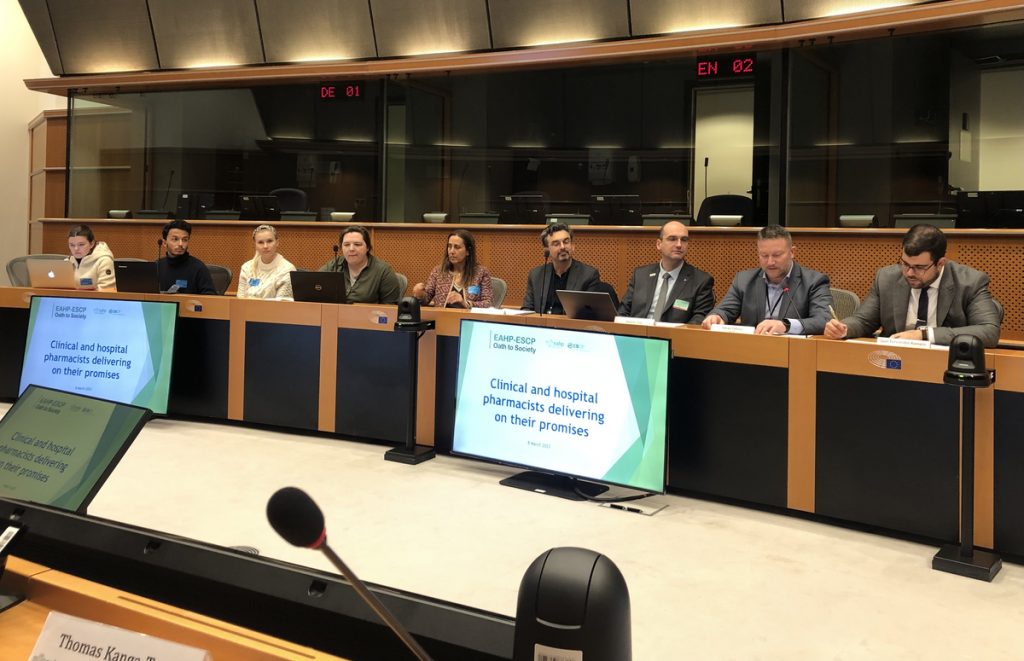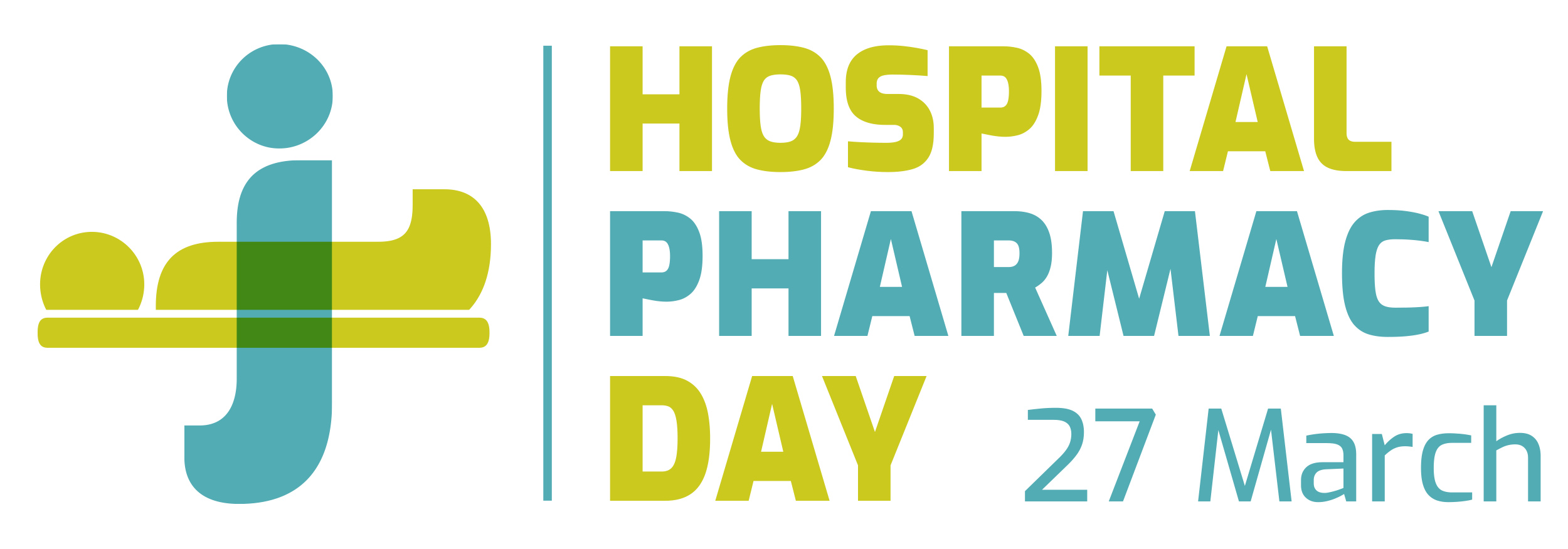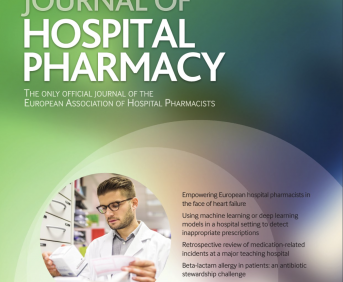DEPRESCRIBING FOR OLDER PATIENTS IN AN EMERGENCY DEPARTMENT DURING CARE TRANSITIONS
Pdf

European Statement
Clinical Pharmacy Services
Author(s)
M.Sc.Pharm., Hanne Fischer; M.Sc.Pharm., Sarah Daaskov Egelund; M.Sc.Pharm., Amalie Bruno-Johansen; Cand.Med. Rune Pihl; M.Sc.Pharm., Ph.D., Charlotte Vermehren.
Why was it done?
Deprescribing for older patients is proposed to mitigate the risks of harm associated with polypharmacy. Deprescribing initiated in the ED is effective only if maintained across healthcare sectors with patient adherence. Some ED pharmacists in Denmark have the authority to approve medication changes in electronic records, potentially enhancing implementation. We aimed to elucidate the degree of implementation of recommended deprescribing interventions across sectors for older patients, facilitated by ED pharmacists. Additionally, we explored differences in implementation based on whether deprescribing was authorized by pharmacists or delegated to an ED doctor or general practitioner (GP).
What was done?
The pilot study was conducted to explore the recommendation and implementation of deprescribing for older patients across sectors, facilitated by pharmacists in a Danish Emergency Department (ED).
How was it done?
Pharmacists initiated deprescribing interventions, ensured consensus with the patient and/or ED doctor, respectively, and were assigned responsibility for authorizing medication changes. Pharmacists checked for implementation in the shared medication record (FMK) after 14 and 30 days and contacted, if possible, self-administrated patients 14 days post-discharge to assess adherence. The following were registered:
• Who held the responsibility to authorize?
• What kind of medication was deprescribed?
• To what extent were the changes implemented in FMK after 14 and 30 days?
• What was the adherence for the contacted patients?
What has been achieved?
The study involved pharmacist-led interventions for 39 patients. Twenty-three patients (59%) had their change implemented in FMK after 14 days. Two more patients had their FMK changed between day 14 and day 30. Changes authorized by a pharmacist (nine patients) resulted in an implementation rate of 100%, whereas it was 62% and 27% respectively when delegated to the ED doctor (20 patients) or GP (11 patients). Ten patients were contacted, of which seven confirmed adherences. The deprescribed medication included 43 drugs, corresponding to 35 different generic drugs.
What next?
Pharmacist-led interventions in the ED improve implementation of deprescribing across care transitions. When pharmacists are authorized to make changes themselves rather than delegate to an ED or GP, the degree of implementation may increase. This finding supports the involvement of clinical pharmacists in the ED to promote more extensive deprescribing in clinical practice.
DRIVING CHANGE IN ANTIBIOTIC STEWARDSHIP: A PHYSICIAN-PHARMACIST COLLABORATION IN THE ICU AND SURGICAL WARDS (IN VIENNA)
European Statement
Clinical Pharmacy Services
Author(s)
Lisa Wimmer, Beata Laszloffy, Tamara Clodi-Seitz, Doris Haider
Why was it done?
Antibiotic resistance poses a serious threat to global health, and Austria’s National Action Plan on Antibiotic Resistance (NAP-AMR) highlights the urgency of robust antibiotic stewardship, especially with the 2024 implementation of new antimicrobial quality standards. In response, a 700-bed hospital in Vienna has launched an ambitious initiative, forming a dedicated Antibiotic Stewardship (ABS) team. This interdisciplinary collaboration between physicians and clinical pharmacists is designed to revolutionize antibiotic use, curb resistance, and elevate patient care standards starting in the ICU and associated surgical units.
What was done?
The ABS team took decisive action by targeting one intensive care unit (ICU) and two surgical wards (64 beds in total) for weekly screenings. Infectious disease specialists and clinical pharmacists worked hand-in-hand, meticulously reviewing every patient’s case. This dynamic collaboration ensured not only the highest level of medication safety but also the relentless optimization of antibiotic use, pushing boundaries to meet and exceed best-practice standards.
How was it done?
The ICU and surgical wards—hotspots for antibiotic overuse—were strategically chosen for weekly reviews. In these high-risk areas, an interdisciplinary collaboration of physicians and clinical pharmacists joined forces, taking swift action to assess and fine-tune prescriptions. Pharmacists played a hands-on role, actively reviewing antibiotics and other medications, making recommendations, adjusting dosages, and halting unnecessary treatments. This collaboration was crucial in driving evidence-based decisions that directly elevated patient care to new heights.
What has been achieved?
After just four months, the project has already made significant strides, affecting a substantial number of patients. The majority of interventions have centered on refining antibiotic use, while additional recommendations on other medications have strengthened overall treatment safety. This close collaboration between physicians and pharmacists has directly improved adherence to national guidelines and sharpened prescribing practices.
What next?
Building on early successes, the ABS team will expand screening to additional departments, establishing a pivotal role for clinical pharmacists. This initiative serves as a model for other hospitals, demonstrating that significant improvements in antibiotic stewardship are possible, even with limited resources. The key takeaway: small steps can drive substantial gains in patient care and antibiotic use. As the program progresses, measurable effects on resistance patterns and antibiotic consumption are anticipated.
MONITORING OF PRESCRIPTIONS FOR VOLUNTARY INTERRUPTION OF PREGNANCY AND SPONTANEOUS ABORTION WITHIN THE FIRST TRIMESTER OF PREGNANCY
Pdf

European Statement
Clinical Pharmacy Services
Author(s)
V. Mureddu, G. Ledda, G. Adamu, M. Rivano, A. Cadeddu. Hospital Pharmacy Department, Azienda Ospedaliero Universitaria, Cagliari.
Why was it done?
Mifepristone and misoprostol are provided for Voluntary Pregnancy Interruption (VPI) and Spontaneous Miscarriage (SM) according to different reimbursement schemes, based on different gestational age. According to Summary of Product Characteristics (SPC), the use of mifepristone and misoprostol is approved only within the first 63 days of pregnancy. Recently, access to treatment for VPI and SM has been extended by the Italian Medicines Agency by the I trimester of pregnancy. VPI within the first 49 days of gestation, the use of mifepristone and misoprostol is authorized according to SPCs. From 50th to 63th days is guaranteed under the law 649/96, that allows and reimburses the use of medicines for off-label indications. From 63th to 90th is considered an off-label prescription. Regarding SM, mifepristone and misoprostol can be used within the I trimester under the law 648/96. All these different reimbursement schemes are used as part of the Italian pricing-reimbursement system.
What was done?
To ensure appropriateness, a specific prescription form has been drafted to support clinicians in prescribing according to the correct reimbursement scheme gestational age, therapeutic indication and dosage must be reported in the prescription form.
How was it done?
The development of the prescription form required a deep knowledge of both the law under which the right of abortion is guaranteed and Italian reimbursement schemes. The prescription form was introduced in October 2022.
Prescriptions of all pharmacological treatments are ordinarily made through electronic software; therefore the prescription form was uploaded. Prescriptions from 01/01/2024 to 30/06/2024 were collected and retrospectively analyzed.
What has been achieved?
Prescription forms analysis showed that a total of 83 women were treated. In 53 cases the treatment was used for VPI and in 30 for SM. In 27% of cases, prescriptions were considered as per in-label. In 66% cases, prescriptions were allowed according to Law 648/96. In 7% of cases, prescriptions were off-label.
What next?
According to the development of reimbursement schemes, the prescription form will be implemented. Italy provides universal coverage for all citizens and residents; keeping it sustainable is one of the hardest challenges of these day. The contribution of hospital pharmacists in monitoring prescriptions has a pivotal role in making equal access to these treatments.
Establishing Population Health Management Clinic (PHMC) in surgical pre-assessment unit at WMUH
Pdf

European Statement
Clinical Pharmacy Services
Why was it done?
Population Health Management is about improving population health by data driven planning and delivery of proactive care to achieve maximum impact.
The aim was to Introduce ‘Making Every Contact Count’ approach in the pre-assessment unit of engaging in conversations with patients about their lifestyle and providing the tools and information they need to make meaningful changes in managing
Hypertension, Diabetes
Smoking, Consuming alcohol, high BMI
Regular physical exercise, Healthy eating schedule
Adherence to prescribed medicines
In addition, establish link with the community public health team for continuous intervention and support.
What was done?
We proposed to the hospital executive management board to develop and test a novel clinical nurse and pharmacist led ‘Population Health Management clinic’ for the hospital that is grounded in connections to key stakeholders in the community, so that patients are followed up to get lifestyle change interventions to improve their illnesses and medication adherence. The board approved the funding and we established the first of its kind population health management clinic in the hospital.
How was it done?
Obtaining funding for the project was an obstacle.
We surveyed 1,000 patients who attended the pre-assessment unit during the year.
31% were hypertensive, 13% diabetic, 12% were smokers, 29% had anxiety/ depression, 51% drink alcohol more than recommended limit; 50% have BMI >29; 41% were not adherent in taking their regular medicines, 41% do not practice any physical exercise and 50% said they do not follow healthy eating. We presented the audit data to the hospital executive management board proposing to develop a ‘Population Health Management clinic’. The board approved the funding as they found that this is a step forward to improve the health of the population.
What has been achieved?
Since the initiation of the project, the concept of proactive health intervention and life style change approach is well established in the hospital becoming daily practice of the pre-assessment team.
What next?
Establishing Population health management clinic in surgical pre-assessment unit provides a unique ‘teachable moment’, where a patient can be encouraged by a perioperative team to make positive and lasting changes to their lifestyle and medication adherence.
Implementation of a screening circuit and prevention of infections in cancer patients treated with immune checkpoint inhibitors
Pdf

European Statement
Clinical Pharmacy Services
Author(s)
Alba Manzaneque, Carla Jurado , Cristina Alonso , Mireia Cairó, Glòria Molas, Fernando Salazar , Lucía Boix, Roser Font, Laura López, Jordi Nicolás, Marc Campayo, Esther Calbo
Why was it done?
Although an intrinsic risk of infection has not been associated with ICI, there are different studies and case-series in the literature in which an increased risk of infection is observed, mainly associated with the use of immunosuppressive drugs (like corticoids) for immune-mediated toxicities. The objective of implementing this circuit in our centre is to reduce all preventable infections, by carrying out an initial infection screening that allows detection of those patients susceptible to vaccination measures, prophylaxis, or specific recommendations.
What was done?
Implementation of an infection screening circuit in cancer patients treated with immune checkpoint inhibitor drugs (ICI).
How was it done?
To carry it out, a multidisciplinary work team was created (pharmacy/oncology/infections department) that designed the ICI template and the clinical circuits. At this point, we believed it was necessary to centralise requests, results, and follow-ups in the oncology pharmacy team (OPT) in order to ensure that all patients were included.
Before the patient initiates treatment with ICIs, the OPT makes the request for a pre-established ICI analysis and the oncology nurse (ON) extracts it. Within 7-10 days, the infection department checks the results and makes the necessary recommendations (vaccination/prophylaxis/specific recommendations).
The OPT is then responsible for both vaccination and initiation of prophylaxis.
What has been achieved?
A total of 30 patients (January to September 2022) have been included in the circuit, 25/30 being men and with a mean age of 67.8 (± 8.8) years.
In 25/30 the treatment was with palliative intent, and 21/30 had lung neoplasia.
The ICIs prescribed were: pembrolizumab (15/30) and nivolumab/atezolizumab/durvalumab (5/30 in each case).
Screening results are available for 26/30 patients. Some type of recommendation was made in 25/26 patients, being: 20/26 hepatitis B vaccination, 5/26 start prophylaxis (2/5 hepatitis B and 3/5 tuberculosis), 6/26 hygienic-dietary measures (aimed at toxoplasmosis).
Additionally, all previously unvaccinated patients (23/26) have been vaccinated against pneumococcus.
What next?
A comparative analysis of infection with a historical cohort is planned when larger sample size is available, to demonstrate that these types of measures reduce the occurrence of infections. Centralising this type of initiative from the OPT is key to our integration into clinical teams, by avoiding important adverse reactions and taking care of our patients.
Extensive renal pharmacotherapy course for hospital pharmacists
Pdf

European Statement
Clinical Pharmacy Services
Why was it done?
Kidney disease carries a significant worldwide health burden. In more the incidence of stage III chronic kidney disease in more than 9%. Many hospitals in Oman have special units of nephrology but clinical pharmacy services for these patients are almost none. It was important to upskill practicing pharmacists’ knowledge and skills to provide comprehensive pharmaceutical care for patients with renal diseases.
What was done?
An online 8-week course was developed by an experienced and certified renal clinical pharmacist with an aim of enhancing the knowledge and skills of pharmacists practising in primary, secondary and tertiary care hospitals in Oman. The course covered all the topics required to develop the skills of the pharmacists to enable them to deal with renal prescriptions and be able to intervene in any medication related problem in patients with kidney diseases. Before and after knowledge assessment was done for the participants to enable justify the benefits of the Course. Towards the end of the course a satisfaction survey was also completed by the participants to provide ensure achieving desired outcomes.
How was it done?
The course was hybrid and the beginning with some sessions carried out face-to-face and some online.
The course included topics such as acute kidney injury, chronic kidney disease, drug induced kidney diseases, medication management in renal replacement therapy and kidney disease complications. The course was interactive with case study discussions, question and answer sessions and some assignments done by the participants at home. The course was designed based on Kirkpatrick foundational principles with consideration of the four levels of learning.
What has been achieved?
Twenty pharmacists participated in the first cohort and 23 in the second cohort. The attendance was more than 90% throughout the course. The pharmacists were keen to learn and ask questions. There was a clear difference in knowledge before and after the course with only 19% of participants passing the pre-course assessment compared to more than 80% of participants passing the post-course assessment.
What next?
The course was highly appreciated by the participants and would run the course and regular intervals with considerations to applications from the Gulf region since they share similar practice and disease burden.
Initial observations on the implementation of a clinical pharmacy service in a rural hospital in Austria
European Statement
Clinical Pharmacy Services
Author(s)
Sonja Guntschnig, Aaron Courtenay, Ahmed Abuelhana, Michael Scott
Why was it done?
The service was established as part of the implementation of a new pharmacy into the hospital. The aim of this good practice initiative was to introduce multidisciplinary work on the wards and provide clinical pharmacy support for the ward personnel. Furthermore, it determined what types of clinical pharmacy interventions are needed at a rural 360-bed hospital in Austria, and assessed the physicians’ acceptance rate of the pharmacists’ suggestions.
What was done?
A new clinical pharmacy service (CPS) was introduced into Tauernklinikum Zell am See.
How was it done?
Data on 550 interventions made by one clinical pharmacist were collected by convenience sampling over a one-year period and rated on a six-point clinical significance scale. A subset of 26 interventions was rated for clinical significance by four independent physicians to determine inter-rater reliability (IRR). A two-way model inter-rater reliability analysis was performed for the four different physician assessments using SPSS to determine intra-class correlation (ICC).
What has been achieved?
Prompt acceptance rate by the physicians involved was 71.3% (392/550). In 26.9% (148/550) of all cases, the physician considered a change. The overall average score for all 550 clinical pharmaceutical interventions taken was 2.2. ICC significance scores were correlated with the pharmacist’s scores, ICC for consistency was 0.732 and 0.732 for absolute agreement, thus both can be considered as “good”. Potential for cost reduction associated with the recommended pharmaceutical changes, namely with medication being stopped or dose reduction was 32.7% (180/550) and 25.1% (138/550), respectively.
What next?
There is great potential and a definite need for the expansion of CPS in Austria. Only 15.8% of Austrian hospitals have a pharmacy department with even less offering CPS. Many countries have demonstrated the benefits of CPS in hospitals over the past 30 and more years. The need for increased pharmacist staffing in Austrian hospitals needs to be demonstrated to Austrian stakeholders.
IMPLEMENTATION OF AN APPOINTMENT MANAGEMENT MODULE APPLIED TO THE OUTSIDE PATIENT AREA
European Statement
Patient Safety and Quality Assurance
Author(s)
JUDIT PERALES PASCUAL, ANA PÉREZ LÓPEZ, HERMINIA NAVARRO AZNAREZ, ELENA HERRANZ BAYO, MARIA PEREZ MORENO, CARLOS-IGNACIO DIAZ CALDERON HORCADA, Mª REYES ABAD SAZATORNIL
Why was it done?
In 2019 the UPEX attended a large volume of patients without a scheduled appointment, long waits were generated and the pharmacotherapeutic follow-up was complicated. The purpose was to implement an appointment management module to avoid crowds, excessive waiting times, allowing better organizational management of care and knowledge of patients in each type of consultation.
What was done?
An outpatient is a patient who goes to the outpatient unit of their Hospital Pharmacy Service to collect a drug for hospital use/diagnosis or foreign drug (it will be administered without health personnel intervention).
An appointment management system was implemented in accordance with the objectives of the SAMPA project (Service for Registration and Promotion of Adherence to Medicines for Elderly Patients), included in the European STOPandGo project.
How was it done?
Creating a cross-cutting system for the entire clinical circuit from prescription to dispensing involved a great deal computer involvement. Although it began to be used in November 2018, it was not used by the mostly part of prescribing doctors until the end of 2020.
Now, when the patient leaves medical consultation, he/she will go to the pharmacy and will be seen by a pharmacist. Besides, the program will propose a return appointment when it calculates that the patient has a week’s worth of medication, thus preventing the patient from running out of medication. The pharmacist will decide if the patient needs pharmacotherapeutic follow-up.
What has been achieved?
In 2019, 5 services cited patients while in 2020 it was 14; the percentage of patients attending pharmacy cited increased from 73.2%(2019) to 79.4%(2020).
Currently, the pharmacist knows in advance which scheduled patients he has and can establish a better organizational care management and determine in advance if the patient needs a close pharmacotherapeutic follow-up. Additionally, with this system an average waiting time of 03:55min was achieved (in 2019 appointments with waits >30min were recorded).
What next?
The implementation of the appointment management system has made possible to achieve better organizational management of care,avoid crowds,excessive waiting times, and provide better patient care and pharmacotherapeutic follow-up. The proposed solution can be extended to other hospitals.
ANALYSIS OF DISCREPANCIES BETWEEN DATABASES OF DRUG-PLANT INTERACTIONS: A NEW TOOL THAT FACILITATES DAILY DECISION MAKING
European Statement
Clinical Pharmacy Services
Author(s)
Belén Serna Serrano, Victoria Lerma Gaude, Ana Valladolid Walsh, Cristina Del Pozo Carlavilla, Juan Manuel Collado Sanz, Héctor Alabort Ayllón, Eduardo Tébar Martínez, Andrea Drozdz Vergara
Why was it done?
In the pharmacist-patient clinical interview (CI), DP-I revision is frequent due to consumption increase of phytotherapy in recent years. The aim of the initiative was to study the degree of discrepancy (DD) based on the severity criteria (SC) found about the recommendations on the management of DP-I. Nowadays there are multiple databases with lack of unification. Patients diagnosed of Multiple Sclerosis (MS) are frequently interviewed by the pharmacist and they often take herbal medicines (HM).
What was done?
We unified the information collected from the commonly consulted databases of drug-plant interactions (DP-I) whose information could be scarce or contradictory, by creating a tool based on the most consulted plants in our clinical practice (CP).
How was it done?
To create our own DP-I tool, the sources consulted were:
– Our own plant database based on CP. A total of 56 plants.
– Six official databases of DP-I: (A)-Phytotherapy official monographs, (B)-MedInteract®, (C)-Micromedex®, (D)-UpToDate-Lexicomp® (E)-Medscape®.
In order to unify the DP-I information consulted and to be able to identify the DD (0 to 2), the SC for all databases were unified in 3 levels: if the database had 5 levels (1=1-2; 2=3-4; 3=5) or 4 levels (1=1-2; 2=3; 3=4). In first place we decided to test this tool with a small sample size of drugs (6 drugs commonly used for the treatment of MS) to check whether the discrepancy between the databases usually consulted was significant or not.
What has been achieved?
Finally, 6 DP-I were detected with Hypericum perforatum (HP) and Echinacea angustifolia (EA):

The DD seems to be similar between A-B databases and greater respect to the rest of them. Depending on the database consulted the pharmacist’s performance could change and consequently, pharmaceutical care may be affected. Since this tool was implemented in our CP, none of our MS patients have taken HP or EA, therefore, it has not been necessary to modify their treatment because of DP-I.
What next?
This tool could speed up the pharmacological review of possible DP-I and improve decision-making for the care of MS patients. Our next step is to increase the sample of analysed drugs commonly used in other pathologies, such as antiretroviral drugs.
Impact of a specialist pharmacist on hepato-pancreatico-biliary (HpB) surgical ward rounds at a large tertiary liver centre.
European Statement
Clinical Pharmacy Services
Author(s)
Connor Thompson, Alison Orr
Why was it done?
Surgical patients are at risk of medication-related adverse events, with some of these patients having co-morbidities requiring long-term medications prior to surgery. Published data suggests pharmacist interventions can reduce adverse drug reactions (ADRs) and medication errors and reduce hospital length of stay.
What was done?
The effect of implementing a pharmacist into the HpB surgical ward round (WR) was unknown, this would also support ongoing service development projects in liver pharmacy on patient pathways.
This study aimed to establish the range and clinical impact of interventions made by the specialist pharmacist when attending HpB post-surgical WR as part of ongoing pharmacy engagement and service development.
How was it done?
A prospective study looking at interventions of a specialist pharmacist on WR over a one-month period, attending two WR per week. Review of all post-surgical HpB on an inpatient ward. All interventions collated and categorised based on commonality.
What has been achieved?
Over the course of data collection, the pharmacist reviewed 140 patients and made 477 interventions as part of the WR. This included 45 history medications being started, identification of 32 ADRs to current treatment, 16 instances of vancomycin dose adjustments, confirmation of anticoagulation for 17 patients and addition of 101 antibiotic stop dates contributing to better antimicrobial stewardship. There were also 70 instances of a nurse/doctor/patient requiring additional information on medication treatments.
What next?
This has highlighted the scale of interventions a pharmacist can make on a WR. Emphasising not only adjustment of medications but also the need for medication related information by healthcare professionals and patients alike.
Moving forward a pharmacist will attend at least two WR per week, with potential scope for support in pre-assessment and post-operative clinics to review weaning of analgesia and long-term management of pancreatic replacement for example.
With the recent announcement regarding new standards for the initial education and training of pharmacists in the UK, it would be valuable to assess the impact of a prescribing pharmacist on these WR.





